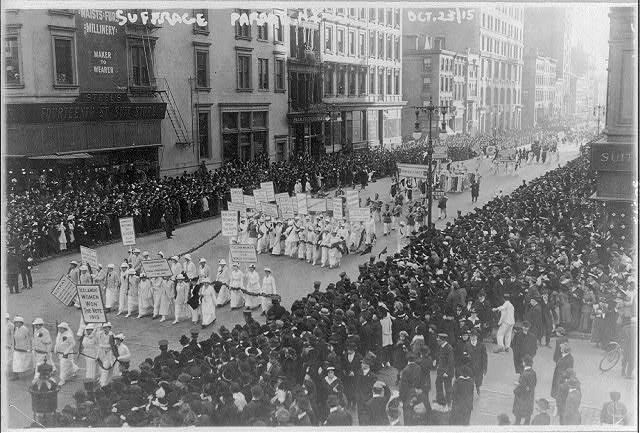Suffrage for women in the United States was an uphill struggle. Despite even the reminder from the earliest days of the Revolution with Abigail Adams writing to her husband, "Don't forget the Ladies," the right to vote had been kept from women for over a century. While many abolitionists worked with the suffrage movement, once the Civil War ended and the Thirteenth, Fourteenth, and Fifteenth Amendments provided rights for African Americans, women's suffrage seemed forgotten. Leaders like Susan B. Anthony and Elizabeth Caddy Stanton continued the fight, but great political ground was made until well into the twentieth century.
America had joined World War I in April of 1917 amid a fair amount of protest of the involvement in Europe's war. President Woodrow Wilson used propaganda machines to keep the war popular, showing films of troops in training, "minute-men" giving public speeches over the importance of making the world safe for democracy, and upholding ideals of everything American. Meanwhile, the National Woman's Party, the renamed union of many women's suffrage organizations, used negative publicity against the President. He was routinely questioned why women weren't in his agenda of support for all humankind. Women picketed the White House with placards demanding the right to vote. Other placards displayed anti-war slogans, which was growing among the movement.
The protesters, nicknamed the "Silent Sentinels", had gradually ended their silence days before. As the President drove by, tipping his hat as he usually did, the women shouted at him. Outraged bystanders began to clash with the protesters, and eventually the police were brought in to calm the situation by arresting many of the women on charges of obstructing traffic. In the altercation, one of the leaders of the suffragettes, Alice Paul of New Jersey, violently slipped out of a policeman's grasp and fell, hitting her head on the pavement. Police and protesters alike attempted medical help, but Alice died in a matter of minutes. The women rose up in what many called a "riot", but police quickly arrested whoever they could catch to be placed in the Occoquan Workhouse in Virginia.
As the media and the remainders of the NWP spread word about the death, Wilson faced a public relations disaster. In a change from his usual quiet on the subject, he approached Congress with a speech requesting women's suffrage, noting that they "were willing to die, just as any man in the Revolution had been." Meanwhile, the negative press only grew as the arrested women entered hunger strikes. Potential bills flew around the Congress, drowning out suggestions for a temperance amendment controlling alcohol. Opposition to suffrage repeated pseudo-scientific evidence that women had smaller brains, and it was on a demand that women could think just as well as men that a solution was found. Common throughout the South, poll tests would be established to prove literacy and basic knowledge of citizenship for a voter. The Eighteenth Amendment, establishing the National Poll Test, would be ratified January 6, 1919. Any citizen of the United States, male or female, black or white, and even of any age, could vote after passing the test and proving merit.
As the Test went into use around the United States, it became steadily obvious that, statistically, the poor would be the first to be turned away from voting. Only a few who recognized this matter took it seriously, and of those, there were ones who used it to their advantage. Workers' rights were a question of the unskilled laborers, but the increasing difficulty of the Test kept them from voting. As the economy sank into the Great Depression, social leaders spoke out against the Test. Facing his own public relations issues, President Franklin Roosevelt urged Congress to repeal the amendment with a new amendment continuing the guarantee the vote for all adults, men and women. The Nineteenth Amendment would repeal the Eighteenth in 1933, the first of many political shifts for the nation.
Although ignored in 1917, the idea of the prohibition of alcohol would arise again in 1937 along with the control of marijuana. After two decades of facing an explosion in organized crime, these measures, too, would be repealed under the presidency of Stuart Symington in 1963 shortly before his assassination in Dallas, Texas.
--
In reality, no one was seriously injured at the NWP protest, though many were arrested, including leaders Lucy Burns and Alice Paul. While in Occoquan Workhouse, they would begin hunger strikes that would lead to them being force-fed while under psychiatric watch. The resulting negative press would push the government for an amendment to give women the vote, but not until after the Eighteenth Amendment began the Great Experiment of prohibition.

No comments:
Post a Comment